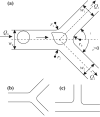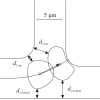Simulated two-dimensional red blood cell motion, deformation, and partitioning in microvessel bifurcations
- PMID: 18686035
- PMCID: PMC2574853
- DOI: 10.1007/s10439-008-9546-4
Simulated two-dimensional red blood cell motion, deformation, and partitioning in microvessel bifurcations
Abstract
Movement, deformation, and partitioning of mammalian red blood cells (RBCs) in diverging microvessel bifurcations are simulated using a two-dimensional, flexible-particle model. A set of viscoelastic elements represents the RBC membrane and the cytoplasm. Motion of isolated cells is considered, neglecting cell-to-cell interactions. Center-of-mass trajectories deviate from background flow streamlines due to migration of flexible cells towards the mother vessel centerline upstream of the bifurcation and due to flow perturbations caused by cell obstruction in the neighborhood of the bifurcation. RBC partitioning in the bifurcation is predicted by determining the RBC fraction entering each branch, for a given partition of total flow and for a given upstream distribution of RBCs. Typically, RBCs preferentially enter the higher-flow branch, leading to unequal discharge hematocrits in the downstream branches. This effect is increased by migration toward the centerline but decreased by the effects of obstruction. It is stronger for flexible cells than for rigid circular particles of corresponding size, and decreases with increasing parent vessel diameter. For unequally sized daughter vessels, partitioning is asymmetric, with RBCs tending to enter the smaller vessel. Partitioning is not significantly affected by branching angles. Model predictions are consistent with previous experimental results.
Figures







References
-
- Ascher UM, Petzold LR. Computer Methods for Ordinary Differential Equations and Differential-Algebraic Equations. Society for Industrial and Applied Mathematics; Philadelphia: 1998. pp. 73–82.
-
- Audet DM, Olbricht WL. The motion of model cells at capillary bifurcations. Microvasc.Res. 1987;33:377–396. - PubMed
-
- El-Kareh AW, Secomb TW. A model for red blood cell motion in bifurcating microvessels. International Journal of Multiphase Flow. 2000;26:1545–1564.
-
- Enden G, Popel AS. A numerical study of the shape of the surface separating flow into branches in microvascular bifurcations. J.Biomech.Eng. 1992;114:398–405. - PubMed
-
- Enden G, Popel AS. A numerical study of plasma skimming in small vascular bifurcations. J.Biomech.Eng. 1994;116:79–88. - PubMed
Publication types
MeSH terms
Grants and funding
LinkOut - more resources
Full Text Sources

